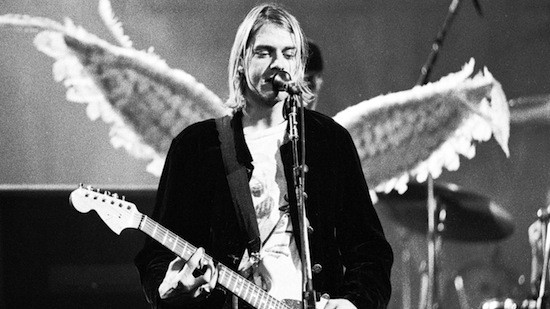Even though Nirvana drummer, Foo Fighters frontman, and ambassador of rock in the twenty first century Dave Grohl was not interviewed by director Brett Morgen for the documentary Kurt Cobain: Montage of Heck, he still gets the film’s best single line. In a Nevermind tour-era television interview, Grohl, bassist Krist Novoselic, and Kurt Cobain are asked about the rapturous reviews the album has been getting.
“If I read that stuff about another band, I wouldn’t believe it.” Grohl says, inadvertently summing up Nirvana’s entire career.

Kurt Cobain: Montage of Heck is the first documentary to be authorized by the Cobain estate—in other words, it was Courtney Love’s idea. Director Morgen, who co-directed The Kid Stays In The Picture, the excellent 2002 documentary about legendary film producer Robert Evans, had access to thousands of photographs, notebooks, journals, audio tapes, and hours of never-before seen video.
The film’s title is taken from a psychedelic audio collage tape Cobain made while living in Olympia, Washington with his first girlfriend Tracy Marander, whose interview is one of the most interesting parts of the film. For the audio material where there was no video accompaniment, Morgen adds animations in a variety of styles. In some animated sequences, drawings and comics Cobain created are used as jumping-off points, to mixed results. Some of the best animation comes from Husko Husling, who renders Cobain’s hometown of Aberdeen as moody, dark acrylic paintings.
Grohl is not the only person in the Cobain story who was not interviewed for the film. If you’re looking for insight about the band’s interpersonal relations, the network of 80s alternative bands who nurtured Nirvana and were in turn plugged by Cobain when he was in the international spotlight, or analysis of why Kurt, Krist, and Dave made it huge when equally talented acts like The Pixies remained cult figures, you won’t find them in this movie. What you will find is an intense, intimate portrait of Cobain that makes him look less like the “the last real rock star” and more like an everyman. He was an outcast in a small, football-obsessed town, a sensitive kid who never recovered from his parents’ divorce when he was nine years old. He was diagnosed as ADD at 10 and given ritalin. He hung out with losers and punks because they were the only people who would accept him. Music was the only thing that brought him joy, so he tried to find a band to play with until he hooked up with Novoselic, and the pair became best friends. In the film, there’s no mention of the parade of drummers the pair went through before finding Grohl or the transition from Sub Pop indie rock darlings to David Geffen-backed superstars.
The extensive archival material, which includes such gems as Nirvana playing to an audience of two in an Olympia, Washington practice space, the notebook where the Cobain listed potential names, outtakes from the famous Nevermind cover photograph, raw footage from the “Smells Like Teen Spirit” video shoot, and a home recording of Cobain singing The Beatles “And I Love Her” to Love, recreates the unseen context from which the Nirvana legend grew. Stripped of her riot grrrl exterior, Love appears just as vulnerable, broken, and talented as Cobain. It’s suddenly easy to see why he fell in love with the most hated woman of the 1990s; as Novoselic says, “She was intelligent, artistic…and she did a lot of drugs.” Love didn’t drive Cobain into junkiedom. She didn’t have to. Heroin, like punk rock, was one of their shared interests.
But there’s one piece of famous Cobain audio missing: the recording of Love reading Cobain’s suicide note at the Seattle memorial service four days after he was found dead. The mixture of raw pain, sarcasm, and lashing anger in her voice were seen by many as proof of her callousness at the time, and cemented her reputation as an evil harpy. Listening to it in the context created by Montage Of Heck, her reaction is perfectly understandable, and even more heartbreaking.
Kurt Cobain: Montage Of Heck is currently airing on HBO and available on demand on HBO Go.